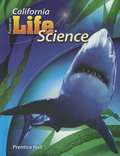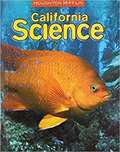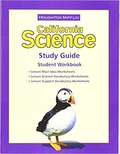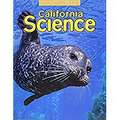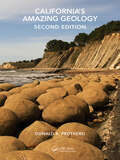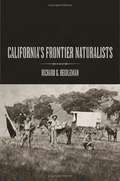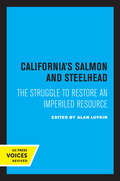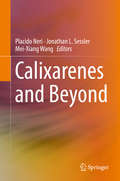- Table View
- List View
California Science Explorer: Focus on Earth Science
by Steve Miller Joseph D. Exline Barbara Brooks Simons Linda Cronin Jones Carole Garbuny Vogel Carbuny Vogel Fred Holtzclaw Thomas R. WellnitzThe state of California has established guidelines, or standards, describing science knowledge and skills for which students in grades six through eight are responsible.
California Science Grade 2
by Houghton MifflinUnit A: Life Cycles; chapter 1: Plant Life Cycles, chapter 2: Animal Life Cycles. Unit B: Earth's Resources; chapter 3: Rocks, soils, and Fossils,. chapter 4: Using Resources. Unit C: Motion and Forces; Chapter 5: Objects in Motion, Chapter 6: Forces. Unit D: Magnets and Sound; chapter 7: Magnets, chapter 8: Making Sound. 304 pages
California Science Grade 4 Interactive Text
by Macmillan Mcgraw-HillA fourth grade science book that broadly covers: living things, rocks and minerals, electricity, magnetism among others.
California Science Grade 5 Study Guide Student Workbook
by Houghton MifflinCalifornia Science Grade 5 Study Guide Student Workbook
California Science Interactive Text
by Houghton MifflinPlant & Animal Life Cycles, Rocks, Soils, and Fossils, Using Resources, Objects in Motion, Forces, Magnets, Making Sound.
California Science Interactive Text (Grade #3)
by Houghton MifflinScience textbook for 3rd graders.
California Science Interactive Text (Grade #5)
by Houghton MifflinAll living things need to make or take in food. Living things need a way to take care of and protect their bodies. They also need to grow and reproduce, or make more living things of the same kind. They need a way to get rid of waste, too.
California Science Interactive Text (Grade #6)
by Houghton MifflinA book for students to learn about Earth's structure, mountains, earthquakes, volcanoes etc.
California Science Interactive Text 5th Grade
by Macmillan Mcgraw-HillThe California Science interactive text contains eight chapters and the topics include Structure of Living Things, Plant Structure and Functions, Human Body Systems, Earth's Water, Earth's Weather, The Solar System, Types of Matter and Changes in Matter.
California Science Level 3: Study Guide Student Workbook
by Houghton MifflinSurvival of Living Things, Patterns in the Sky, Matter, Energy.
California Science Study Guide Student Workbook Grade 4
by Houghton MifflinCalifornia Science Study Guide Student Workbook Grade 4
California Science [Grade 5]
by Douglas Carnine William Badders James FelicianiGrade 5 science textbook
California Science,Grade 3, Interactive Text
by Unknown AuthorScience Interactive Text Grade 3 Student Edition
California Science: Reading and Writing in Science (Grade #5)
by The Editors at the The McGraw-HillThis book covers essential topics for grade 5 students like Plant Structures and Functions,Human Body Systems,Types of Matter etc.
California Spring Wildflowers: From the Base of the Sierra Nevada and Southern Mountains to the Sea
by Philip A. MunzThis title is part of UC Press's Voices Revived program, which commemorates University of California Press’s mission to seek out and cultivate the brightest minds and give them voice, reach, and impact. Drawing on a backlist dating to 1893, Voices Revived makes high-quality, peer-reviewed scholarship accessible once again using print-on-demand technology. This title was originally published in 1961.This title is part of UC Press's Voices Revived program, which commemorates University of California Press’s mission to seek out and cultivate the brightest minds and give them voice, reach, and impact. Drawing on a backlist dating to 1893, Voices Revived</DIV
California's Amazing Geology
by Donald R. ProtheroCalifornia has some of the most distinctive and unique geology in the United States. It is the only state with all three types of plate boundaries, an extraordinary history of earthquakes and volcanoes, and it has many rocks and minerals found nowhere else. The Golden State includes both the highest and lowest point in the continental US and practically every conceivable geological feature known. This book discusses not only the important geologic features of each region in California, but also the complex geologic four-dimensional puzzle of how California was assembled, beginning over 2 billion years ago. The author provides up-to-date and authoritative review of the geology and geomorphology of each geologic province, as well as recent revelations of tectonic history of California’s past. There are separate chapters on some of California’s distinctive geologic resources, including gold, oil, water, coastlines, and fossils. An introductory section describes basic rock and mineral types and fundamental aspects of plate tectonics, so that students and other readers can make sense of the bizarre, wild, and crazy jigsaw puzzle that is California's geological history.
California's Amazing Geology
by Donald R. ProtheroCalifornia has some of the most distinctive and unique geology in the United States. It is the only state with all three types of plate boundaries, an extraordinary history of earthquakes and volcanoes, and many rocks and minerals found nowhere else. The Golden State includes both the highest and lowest points in the continental US and practically every conceivable geological feature known. This book discusses not only the important geologic features of each region in California but also the complex geologic four-dimensional puzzle of how California was assembled, beginning over two billion years ago. The author provides an up-to-date and authoritative review of the geology and geomorphology of each geologic province, as well as recent revelations of the tectonic history of California’s past. There are separate chapters on some of California’s distinctive geologic resources, including gold, oil, water, coastlines, and fossils. An introductory section describes basic rock and mineral types and fundamental aspects of plate tectonics, so that students and other readers can make sense of the bizarre, wild, and crazy jigsaw puzzle that is California's geological history.In this second edition, the book has an entirely new final section, “California’s Environmental Hazards and Challenges,” with new chapters on California’s landslides, air and water pollution, renewable energy, and the future of climate change in California.Key Features Thoroughly updates the market-leading textbook on California's geology Is written by an author with 30 years of teaching geology and leading field trips in California Introduces California's unique geological history Covers fundamentals of geology Characterizes specific geographical regions of California Describes major geological resources of California Summarizes the paleontology of California Reviews the likely impact of climate change on California's environment Related TitlesHollocher, K. A Pictorial Guide to Metamorphic Rocks in the Field (ISBN 978-11380-2630-8)Glavovic, B. et al. Climate Change and the Coast: Building Resilient Communities (ISBN 978-04154-6487-1)
California's Fading Wildflowers: Lost Legacy and Biological Invasions
by Richard A. MinnichEarly Spanish explorers in the late eighteenth century found springtime California covered with spectacular carpets of wildflowers from San Francisco to San Diego. Yet today, invading plant species have devastated this nearly forgotten botanical heritage. In this lively, vividly detailed work, Richard A. Minnich synthesizes a unique and wide-ranging array of sources--from the historic accounts of those early explorers to the writings of early American botanists in the nineteenth century, newspaper accounts in the twentieth century, and modern ecological theory--to give the most comprehensive historical analysis available of the dramatic transformation of California's wildflower prairies. At the same time, his groundbreaking book challenges much current thinking on the subject, critically evaluating the hypothesis that perennial bunch grasses were once a dominant feature of California's landscape and instead arguing that wildflowers filled this role. As he examines the changes in the state's landscape over the past three centuries, Minnich brings new perspectives to topics including restoration ecology, conservation, and fire management in a book that will change our of view of native California.
California's Frontier Naturalists
by Richard G. BeidlemanThis book chronicles the fascinating story of the enthusiastic, stalwart, and talented naturalists who were drawn to California's spectacular natural bounty over the decades from 1786, when the La Pérouse Expedition arrived at Monterey, to the Death Valley expedition in 1890-91, the proclaimed "end" of the American frontier.
California's Salmon and Steelhead: The Struggle to Restore an Imperiled Resource
by Alan LufkinMillions upon millions of salmon and steelhead once filled California streams, providing a plentiful and sustainable food resource for the original peoples of the region. But over the years, dams and irrigation diversions have reduced natural spawning habitat from an estimated 6,000 miles to fewer than 300. River pollution has also hit hard at fish populations, which within recent decades have diminished by 80 percent. One species, the San Joaquin River spring chinook, became extinct soon after World War II. Other species are nearly extinct. This volume documents the reasons for the decline; it also offers practical suggestions about how the decline might be reversed. The California salmon story is presented here in human perspective: its broad historical, economic, cultural, and political facets, as well as the biological, are all treated. No comparable work has ever been published, although some of the material has been available for half a century. In the richly varied contributions in this volume, the reader meets Indians whose history is tied to the history of the salmon and steelhead upon which they depend; commercial trollers who see their livelihood and unique lifestyle vanishing; biologists and fishery managers alarmed at the loss of river water habitable by fish and at the effects of hatcheries on native gene pools. Women who fish, conservation-minded citizens, foresters, economists, outdoor writers, engineers, politicians, city youth restoring streambeds—all are represented. Their lives—and the lives of all Californians—are affected in myriad ways by the fate of California's salmon and steelhead. This title is part of UC Press's Voices Revived program, which commemorates University of California Press’s mission to seek out and cultivate the brightest minds and give them voice, reach, and impact. Drawing on a backlist dating to 1893, Voices Revived makes high-quality, peer-reviewed scholarship accessible once again using print-on-demand technology. This title was originally published in 1991.
Calixarenes and Beyond
by Placido Neri Jonathan L. Sessler Mei-Xiang WangContributions featuring the chemistry and applications of a family of macrocyclic compounds collectively known as 'calixarenes' are presented in this edited volume. The arsenal of structures based on calixarenes provides tools which are effective in numerous areas of supramolecular chemistry. The Editors have compiled a timely volume which contains up to date, high calibre contributions from a large number of international authors. A broad perspective on the progress and future of calixarene chemistry is presented. Aimed at students and researchers active in Supramolecular Chemistry.
Call Me Red: A shepherd’s journey
by Hannah JacksonSunday Times bestsellerLessons to live by, without getting up with the lark Hannah Jackson (aka The Red Shepherdess) grew up in the Wirral, and hadn't set foot on a farm until she was 20-years-old. But she'd always loved animals and on a visit to the Lake District, she saw a lamb being born and had a light bulb moment - a burning desire to succeed as a farmer - and never looked back.In Tales of a Shepherdess, Hannah gives us a unique insight into farm life and the values it has taught her that we can use in our everyday lives to change ourselves and our world for the better - from connection, communication and community, to leadership, patience and resilience. Hannah will show us how becoming a lambing and farming contractor in a male-dominated and traditional world taught her grit and determination; how training her loyal sheepdog Fraser taught her to trust; and how sometimes failure can teach us more about ourselves than success. Hannah's journey also teaches us how we should find what sets our hearts on fire and throw everything into it.Hannah's simple and universal wisdom, practical advice, and words of encouragement will inspire you to achieve your goals, follow your dreams and focus on what's really important in life.

